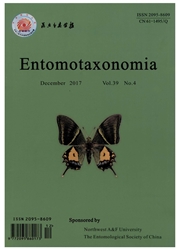

 中文摘要:
中文摘要:
通过3年的室内养殖实验,了解大尾须卵翅蝗Caryanda macrocercusa(Mao et Ren,2007)的生活史和生物学特性。结果表明:大尾须卵翅蝗在云南大理地区1年发生1代;土中的越冬卵平均历期235 d,翌年4月上旬开始孵化;蝗蝻5龄,历期63 d;6月上旬开始羽化,羽化10 d后开始交尾,雌虫交尾后约10-30 d开始产卵,每雌虫产卵8-12个;成虫寿命平均43 d,于7月中旬至8月上旬相继死亡。大尾须卵翅蝗取食荩草、竹叶草等禾本科植物,生活史简单,生物学特性基本清楚,可成为开展蝗虫杂交实验的材料和观赏昆虫养殖对象。
 英文摘要:
英文摘要:
Life cycle and biological characteristics of Caryanda macrocercusa (Mao et Ren, 2007) were investigated during 3 years indoor feed. Experimental results showed that the species kept one generation per year under indoor conditions in Dali, Yunnan Province; the duration of hibernating egg laid in the soil was about 235 days averagely; the egg hatched in early-April next year; the nymph stadiums consisted of 5 instars and lasted for 63 days; the 5th instar emerged in early-June; mating started on the 10th day after eclosion and spawned 8-12 eggs on the 10th-30th day after mating with the duration of adult life being about 43 days and dying from mid-June to early-August individually. Caryanda macrocercusa appears to feed on some grass Arthraxon hispidus and Opli~menus compositus etc. The species with a sample life cycle and clear biological characteristics in principle can be used as a material in hybridization experiment and bred as an ornamental insect.
 同期刊论文项目
同期刊论文项目
 同项目期刊论文
同项目期刊论文
 期刊信息
期刊信息
